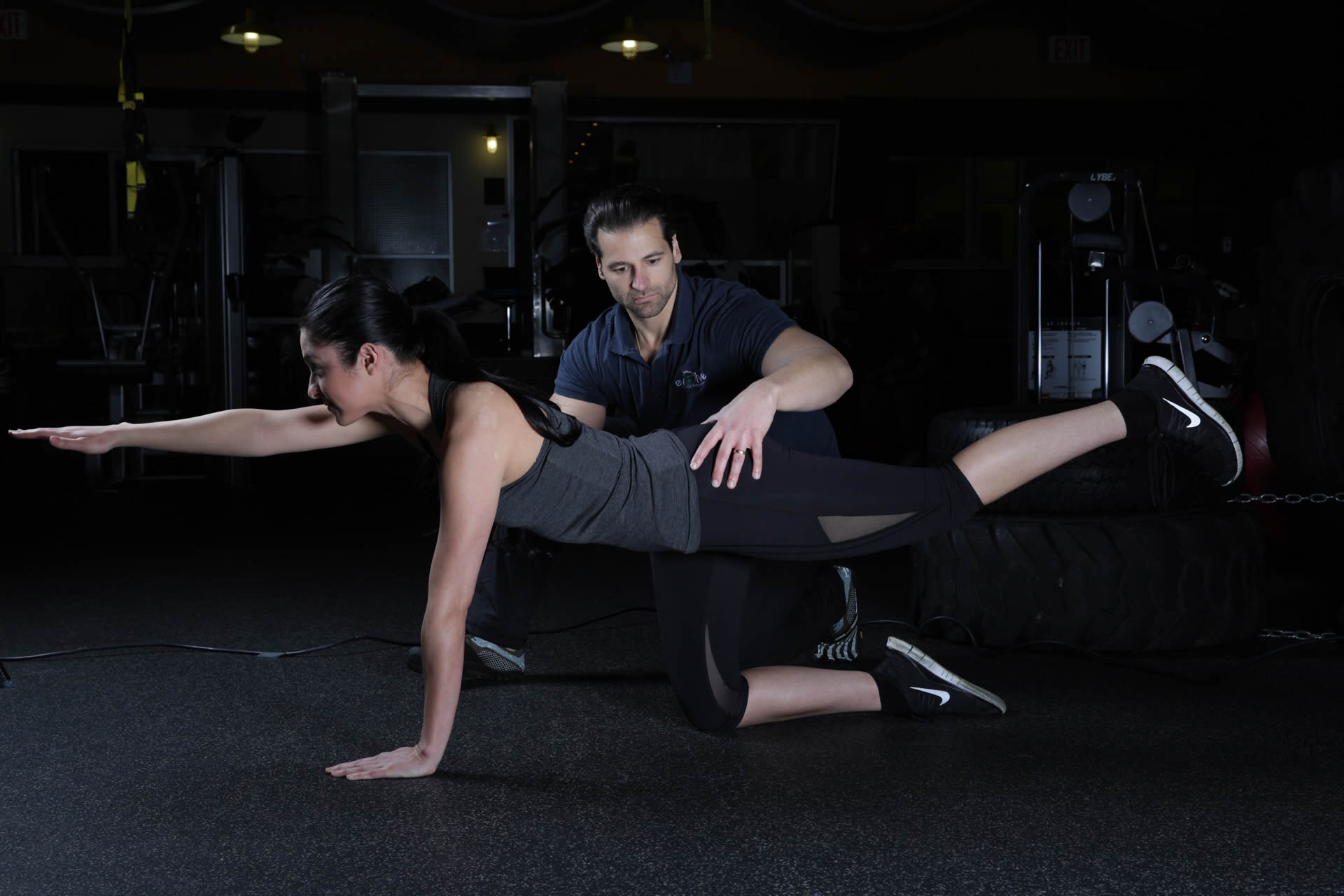
Physical Therapy for Spondylosis
AT EVOLVE
Physical Therapy for Spondylosis
HOW CAN PHYSICAL THERAPY HELP SPONDYLOSIS OF THE SPINE?
Spondylosis is an umbrella term for a number of degenerative changes that can occur in the spine. While in some cases spondylosis may not cause any symptoms, other times it can lead to pain or stiffness in the spine, numbness and tingling or even radiating pain into the arms, hands, legs and feet. If this sounds like you, you are probably wondering what are the best treatment options for this condition? While surgery, injections and medications are certainly one option for managing spondylosis, a conservative treatment approach with physical therapy is an excellent first choice and sometimes more effective than other treatment approaches out there. Physical therapy can help reduce your symptoms and therefore daily function and quality of life.
WHAT DOES PHYSICAL THERAPY FOR SPONDYLOSIS LOOK LIKE?
The hallmark of a good physical therapy program for spondylosis is that it is individualized. My team of therapists and I will always start by getting to know your concerns and goals and performing a thorough physical exam to look for the cause or contributing factors to your symptoms. With all of this knowledge in hand, we will create a custom program that may consist of hands-on techniques performed by our therapists to your spine and nearby areas combined with carefully prescribed movements and exercises performed by you in the clinic and at home.
WHEN WILL I BEGIN TO SEE RESULTS?
Depending on the severity of the degenerative changes, maximal improvement of your symptoms may take time, however, you may begin to see some results right away. Your physical therapist will help to relieve stiffness and discomfort to give you some immediate relief while also creating a plan for longer term symptom management. You should experience improvements in many symptoms such as pain, stiffness, and inflammation within a couple of weeks but returns in strength, flexibility and overall mobility may take longer. Achieving long lasting results may take some time, but dedication to your program will not only help you achieve these results but will help to decrease the likelihood of symptoms recurring in the future.
WHAT CAUSES SPONDYLOSIS?
Spondylosis is a general term for age-related degenerative changes that can occur in the spine. A quick review of spinal anatomy will help you better understand how these degenerative changes can cause symptoms in some people. The spine is composed of 24 vertebrae stacked on top of the sacrum (flat bone at the back of the pelvis) and coccyx (tail bone). The upper spine can be divided into the cervical spine (neck), thoracic spine (mid/upper back) and the lumbar spine (lower back).
Between each of the cervical, thoracic and lumbar vertebrae (except the uppermost 2 bones), lies an intervertebral disc that provides space, shock absorption and cushioning between adjacent vertebrae. Sturdy ligaments run longways through the vertebral column and between segments of the vertebrae to create a stable structure. Small joints between adjacent vertebrae called facet joints allow movement of the spine in its many directions. Finally, running within the canal created by the stacked vertebrae is the spinal cord. The spinal cord is made up of many delicate nerve fibers that carry motor and sensory information between the brain and the muscles, organs, skin and other tissues. Branches of nerves called spinal nerves exit the spinal canal through openings between the vertebrae called formaina.
As we age, changes in these structures can occur. Intervertebral discs become more dry and may crack and lose height, ligaments can thicken and cartilage may become worn down. Spinal stenosis in which the spinal canal or vertebral foramina are narrowed causing pressure or irritation of the spinal cord and spinal nerves may develop as a result of bone spur formation. Discs may be more likely to herniate causing pain and discomfort in the back and potentially into more distant areas of the upper and lower extremities. Finally movement may not be as smooth secondary to loss of cartilage.
HOW DOES SPONDYLOSIS PRESENT?
Usually diagnosed via imaging such as Xrays or MRI, the presentation of spondylosis can vary between people based on what aspects of the spine are involved and how severe the changes are. Here is a list of common signs and symptoms of spondylosis:
- Back or neck pain.
- Back or neck stiffness.
- Numbness or tingling in the arms, hands, legs or feet.
- Muscle weakness in the arms, hands, legs or feet .
- Radiating pain, burning or aching into the arms, hands, legs or feet.
- Back pain after prolonged sitting OR with prolonged standing and walking .
End Injury Progression
Physical therapy for Spondylosis has proven to slow and even stop back pain issues and injury progression in many cases.
Relieve Pain
The movements used in this technique can target your lower back, upper back, hips, shoulders, and neck helping you to manage pain during the course of your physical therapy treatments.
Improve Range of Motion
Posture awareness is an important area to focus on due to the fact that certain positions may cause you further back pain.
Restore Mobility
You can gain mobility and flexibility by taking part in the stretches and exercises as prescribed by your physical therapist.
How Long Will Spondylosis Physical Therapy Treatments Last?
If you decide to work with a physical therapist to help correct your Spondylosis issues, your entire treatment plan could consist of around 8-20+ different physical therapy sessions that will each last 60-90 minutes. Once you complete your customized physical therapy treatment plan, you will be able to continue to do the prescribed stretches and exercises utilized during your PT sessions yet in the comfort of your own home.
WHAT PHYSICAL THERAPY TECHNIQUES ARE USED TO ADDRESS SPONDYLOSIS?
Physical therapy treatment for spondylosis aims to provide symptom improvement while addressing any underlying or contributing factors that may predispose you to recurrence or progression of your symptoms. All of this is done with the goal of allowing you to move more comfortably and remain as active and independent as possible. As mentioned above, my team and I will create an individualized treatment plan based on your unique presentation and the findings of our exam but here are some treatments commonly used to manage spondylosis.
Manual therapy: Manual therapy is a hands-on manipulative type of intervention that your physical therapist can use to address joint hypomobility and soft tissue impairments and to provide some pain relief. Joint mobilizations, soft tissue mobilization and myofascial release are some examples of manual therapy techniques.
Postural re-education and body mechanics training: learning to move well can be an important step to reducing symptoms associated with spondylosis. By learning to adjust your posture and move in an efficient and safe way you can perform more activities with less pain and less irritation on the spinal structures. You will also learn about how to modify your posture or position for activities to minimize symptoms.
Strength and flexibility training:Graded exercises to improve muscle strength and overall flexibility will be prescribed to improve strength, stability and flexibility in the spine. Having adequate strength and flexibility around joints, muscles and other tissues in the neck, back, shoulders, hips and legs can help reduce symptoms associated with degenerative changes and help you feel more capable of moving and performing daily tasks.
Education: understanding the mechanics of your pain and how things that you do in your daily life may be helping or exacerbating your symptoms is an important part of your physical therapy program. Our goal with education is to help you understand your condition and empower you to manage it well in the long run while remaining active and functional.
If you are dealing with spondylosis and ready to find a long-lasting solution to your symptoms call us today to learn more about our services and schedule an evaluation
Mill Basin (located in Harbor Fitness)
6161 Strickland Ave
Brooklyn, NY 11234
Monday: 7am-8pm
Tuesday: 7am-8pm
Wednesday: 8am-5pm
Thursday: 7am-8pm
Friday: 8am-1pm
Park Slope (located in Harbor Fitness)
550 5th Ave.
Brooklyn, NY 11215
Monday: 9am-8pm
Tuesday: 8am-6pm
Wednesday: 9am-8pm
Thursday: 8am-6pm
Friday: 8am-3pm
Gravesend
372 Avenue U
Brooklyn, NY 11223
Monday-Thursday: 8am-8pm
Friday: 8am-3pm
Midwood
945 Kings Highway
Brooklyn, NY 11223
Monday-Thursday: 8am-8pm
Ready to take the next step to a healthier you?
Contact Us Today!
PHYSICAL THERAPY FOR SPONDYLOSIS AT EVOLVE!
Need Physical Therapy for Spondylosis?
Let our caring and compassionate physical therapists help you with relieving pain while getting you back on your feet comfortably.
Call now to schedule your first PT consultation free of charge.
Call: 1-718-395-6551







